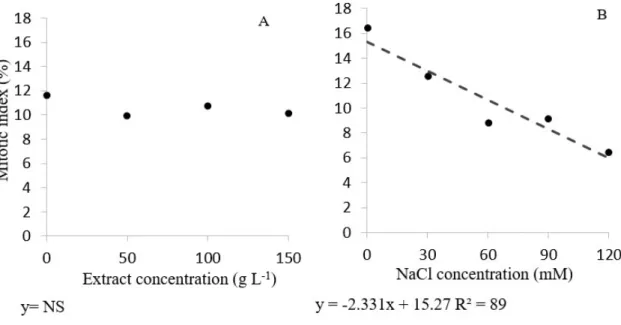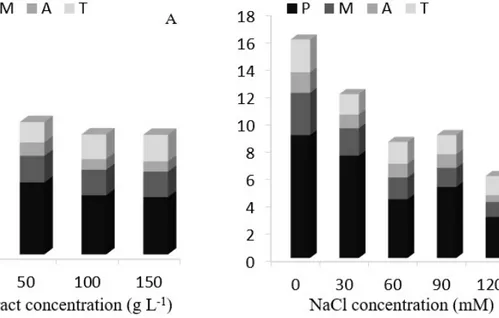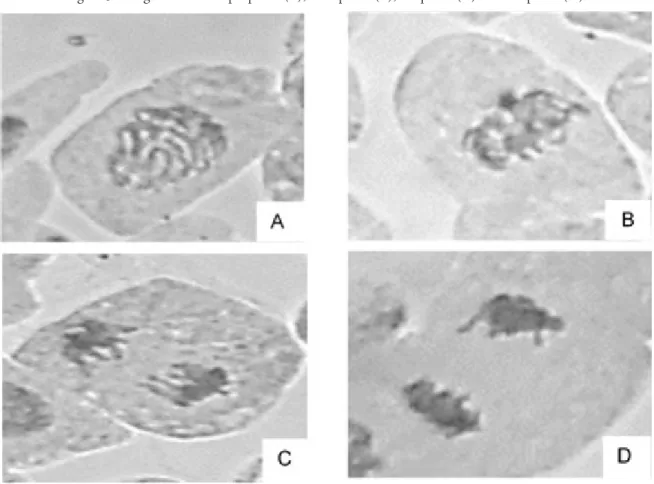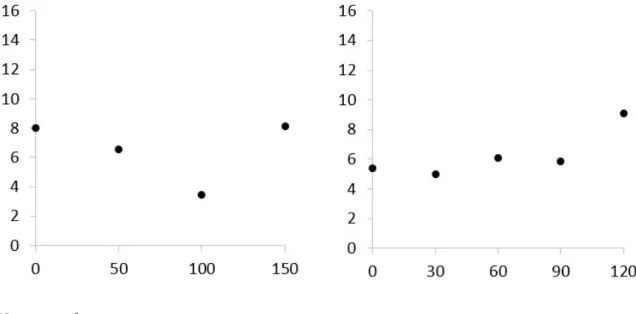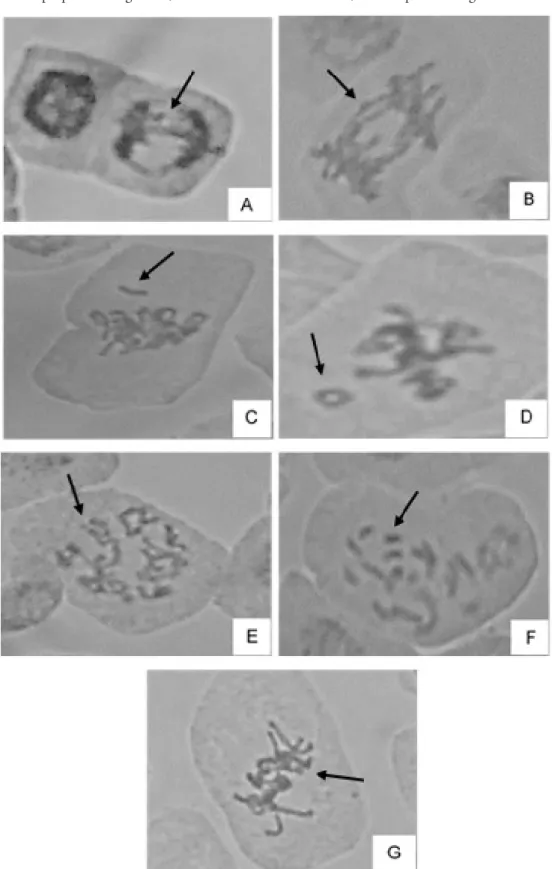Esta obra está licenciada com uma Licença Creative Commons Atribuição-NãoComercial-SemDerivações 4.0 Internacional.
SALT STRESS
EFEITO DO EXTRATO AQUOSO DE FOLHAS DE ALFACE ROXA NA
ATIVIDADE CITOGENÉTICA DE RAÍZES DE ALFACE SOB ESTRESSE
SALINO
Cristiane DeunerI Alison MunhosII Vera Lúcia BobrowskiIII Sidnei DeunerIV Andréia da Silva AlmeidaV Géri Eduardo MeneghelloVI
Abstract: Salinity can affect cell division, causing cytotoxicity, which can lead to inhibition of the mitotic index or chromosomal abnormalities such as the formation of micronuclei, chromosome stickiness, c-mitosis and multipolar anaphases. Plants react to salt stress with biochemical, physiological, cellular adjustments and activate enzymatic and non-enzymatic antioxidative defense mechanisms. Purple lettuce is rich in anthocyanins, compounds that give it high antioxidant activity helping to defend the plant from de salt stress. The aim of this study was to evaluate the effect of different leaf extract concentrations of purple lettuce on the cytogenetic activity of lettuce roots, cv. Regina, from seeds subjected to salt stress. Four extract concentrations of purple lettuce (0, 50, 100 and 150 g lettuce leaves L-1 water) and five concentrations of sodium chloride (0, 30, 60, 90 and 120 mM) were tested, constituting 20 treatments, with distilled water for a negative control. The analyses were of mitotic index (MI), phase index of mitosis (prophase, metaphase, anaphase and telophase) and the presence of chromosomal aberrations. Salt reduces the mitotic index and all index phases of the lettuce roots. The purple lettuce extract does not affect the mitotic index, reduces the cell index in prophase and increases the cells in telophase of lettuce roots. The purple lettuce extract and salt cause chromosomal abnormalities in lettuce root cells; however, a smaller number of mutations is found by applying 100 g L-1 extract.
Keywords: Cell division. Chromosomal abnormalities. Cytotoxicity. Salinity.
DOI: https://doi.org/10.31512/vivencias.v16i31.218
Recebido em: 09-01-2020 Aceito em: 28-04-2020
I Universidade Federal de Pelotas, Pelotas, RS, Brasil. Doutora em Ciências (Fitotecnia).
E-mail: cdeuner@yahoo.com.br II Universidade Federal de Pelotas, Pelotas, RS, Brasil. Licenciado em Biologia. E-mail:
alisonmunhos@gmail.com III Universidade Federal de Pelotas, Pelotas, RS, Brasil. Doutora em Genética e Biologia Molecular. E-mail: vera.bobrowski@gmail.com
IV Universidade Federal de Pelotas, Pelotas, RS, Brasil. Doutora em Agronomia (Fisiologia
Vegetal). E-mail: sdeuner@yahoo.com.br V Universidade Federal de Pelotas, Pelotas, RS, Brasil. Doutora em Ciências. E-mail:
andreaisalmeida@yahoo.com.br V Universidade Federal de Pelotas, Pelotas, RS, Brasil. Doutora em Ciências (Fitotecnia).
Resumo: A salinidade pode afetar a divisão celular, ocasionando citotoxicidade, podendo levar a inibição de índice mitótico ou anormalidades cromossômicas, como a formação de micronúcleos, viscosidade cromossômica, mitose c e anáfases multipolares. As plantas reagem ao estresse salino com ajustes bioquímicos, fisiológicos, celulares e ativam mecanismos antioxidativos de defesa, enzimáticos e não enzimáticos. A alface roxa é rica em antocianinas, compostos que lhe conferem alta atividade antioxidante auxiliando na defesa da planta. O objetivo deste estudo foi avaliar o efeito de diferentes concentrações de extrato de folhas de alface roxa na atividade citogenética de raízes de alface, cv. Regina, a partir de sementes submetidas ao estresse salino. Foram testadas quatro concentrações de extrato de alface roxa (0, 50, 100 e 150 g de folhas de alface L-1 água) e cinco concentrações de cloreto de sódio (0, 30, 60, 90 e 120 mM), constituindo 20 tratamentos, e água destilada para um controle negativo. Foram analisados o índice mitótico (IM), índice de fase da mitose (prófase, metáfase, anáfase e telófase) e a presença de aberrações cromossômicas. O sal reduz o índice mitótico e todas as fases do índice das raízes de alface. O extrato de alface roxa não afeta o índice mitótico, reduz o índice de células na prófase e aumenta as células na telófase das raízes da alface. O extrato de alface roxa e o sal causam anormalidades cromossômicas nas células da raiz da alface.
Palavras-chave: Divisão celular. Anormalidades cromossômicas. Citotoxicidade. Salinidade.
Introduction
The presence of high salinity levels in soils is a factor that can cause abiotic stress and consequently promote a significant reduction in the productivity of different cultures, situation what is observed in various parts of the world (LUCENA et al., 2012; REYES et al., 2012; PEKOL et al., 2016). The high concentration of salts dissolved in the soil solution reduces the osmotic potential, thereby, the availability of water to the plant, during which the production of free radicals or reactive oxygen species (ROS) can occur (WILLADINO and CAMARA, 2010). With the reduction in the water potential of plant tissues, growth restriction occurs, since the rates of elongation and cell division depend directly on the extensibility process of the cell wall (ASHRAF and HARRIS, 2004), and are therefore affected. Saline stress can also cause cell death (OLIVEIRA, 2015). According to Joseph and Jini (2010) and Rezaei et al. (2013) cell death plays an important role in adapting plants exposed to salinity.
At the cellular level, besides affecting cell division, salinity causes chromosomal abnormalities such as the formation of micronuclei, chromosome stickiness, c-mitosis, and multipolar anaphases. The cytotoxicity of substances, like sodium chloride, is assessed by the appearance of changes in the process of cell division of the test organism, both the inhibition of
the mitotic index and the incidence of chromosomal mutations, such as chromatid breaks, loss of whole chromosomes or the formation of micronuclei (SOUZA et al., 2005; TEERARAK et al., 2009). The mitotic index determines the relationship between the number of cells in division and the total number of cells observed, in percentage (BEZERRA et al., 2016).
Plants react to salt stress with morphological, biochemical, physiological, cellular and molecular adjustments (RADIC et al., 2005; TABUR and DEMIR, 2010; PEREZ-CLEMENTE et al., 2013) and activate anti-oxidative defense mechanisms (non-enzymatic and enzymatic). Lettuce is rich in vitamin C and phenolic compounds, and purple varieties also have anthocyanins, pigments that give them higher antioxidant activity (RICE-EVANS et al., 1997), they can help to reduce the harmful effects of salinity to cells.
The effects of salt stress have been extensively studied in different cultures, however, information about the effects of sodium chloride on the mitotic index and percentage of chromosomal aberrations is scarce. Tabur and Demir (2009) found a significant decrease in the mitotic index and a greater number of chromosomal abnormalities in barley seeds grown in different concentrations of NaCl. Radic’ et al. (2005) suggested that high concentrations of salt (300, 450 and 600 mM NaCl) cause total inhibition of mitotic activity and chromosomal abnormalities in meristematic cells of Centaurea ragusina L. Katsuhara.
Lettuce is sensitive to environmental conditions, and there may be problems in germination and emergence (SOLANO et al., 2015), salinity being one of the environmental factors that influence seedling development (KESHAVARZI, 2012; HARTER et al., 2014). In addition, sodium chloride was also considered a potential antimitotic agent in lettuce cells (OLIVEIRA, 2015).
Thus, considering as high levels of sodium chloride can be detrimental to the development of lettuce, affecting cell division and as the purple lettuce variety contains anthocyanins, which can help to protect against salinity, the aim of this work was evaluate the effect of different leaf extract concentrations of purple lettuce on the mitotic index and chromosomal aberrations in lettuce roots, cv. Regina, under salt stress.
Material and methods
The study was conducted in the Didactic Laboratory of Seed Analysis (Departamento de Fitotecnia da Faculdade de Agronomia Eliseu Maciel) and the Genetics Laboratory (Departamento de Ecologia, Zoologia e Genética do Instituto de Biologia) of the Universidade Federal de Pelotas (UFPel), Pelotas-RS.
Four purple lettuce extract concentrations were tested (0, 50, 100 and 150 g lettuce leaves L water-1) combined with five concentrations of sodium chloride (NaCI) (0, 30, 60, 90 and 120 mM), constituting 20 treatments, with distilled water (zero level combination for both factors) as the negative control. For each treatment, eight repetitions of 50 seeds were used.
To obtain the extract, we used lettuce plants purchased from a local fruit market, after noting that they were in good health. Initially, the leaves were washed in distilled water, and
then slightlydried with a paper towel. After, the leaves were weighed separately, according to each treatment, and triturated in a blender containing distilled water for 2 minutes. After being ground, the extracts were filtered through filter paper, and then transferred to the refrigerator, where they remained undisturbed for 24 hours. The combination of factors was performed by adding the corresponding amount of NaCl to the purple lettuce extracts, before performing the tests.
Commercial seed of lettuce, cv. Regina, were germinated in gerbox type plastic boxes, containing blotting paper, which was dampened to 2.5x its dry weight with the solutions, according each treatment, and then placed in a growth chamber at a controlled temperature of 20°C, according the Regras para Análise de Sementes (BRASIL, 2009).
To determine whether there was a protective effect of plant extract on cell division,analyses of mitotic index (MI), mitotic phase index (prophase, metaphase, anaphase and telophase) and the presence of chromosomal aberrations were performed. The mitotic index was obtained by dividing the number of cells by the total number of cells observed and multiplying this by 100, similarly to the index phase. Also, the presence or absence of chromosomal aberrations was evaluated in 400 cells/blade, making a total of 1600 cells per treatment; the rate of chromosomal aberrations was calculated by dividing the number of observed changes by the number of dividing cells, and multiplying this by 100, for each treatment.
To carry out the analysis, a crush technique was employed (GUERRA and SOUZA, 2002). Therefore, four days after sowing, when radicle protrusion was noted, 16 roots per treatment were harvested and fixed in 3 parts ethanol:1 part glacial acetic acid P.A. (Carnoy fixative 3:1), before being left at room temperature for a period of 24h. After this, they were stored in a freezer for subsequent microscopic analysis. To prepare the blade, the rootlets passed through the following process: immersion in distilled water for 5 minutes, followed by hydrolysis in HCl 5N for a period of 15 minutes, and then returning to distilled water for 5 minutes. Then, the rootlets were transferred to the blade, where a stereoscopic microscope was used to enable the removal of the hood to obtain the apical meristem; to this, 2% acetic orcein was added and a cover slip was placed over the crushed material. The blades of lettuce cells were observed by scanning in an optical microscope at a magnitude of 400x using four replicates of 400 cells/ blade, for a total of 1600 cells per treatment (FONSECA et al., 2016).
The design was completely randomized in a 4 x 5 (lettuce concentrations x NaCl concentrations) factorial design with four replications. The results of the mitotic index and chromosomal aberrations were analyzed by polynomial regression statistics with the program Winstat 2.0 (MACHADO and CONCEIÇÃO, 2003). The mitotic phase index was presented with the percentage of dividing cells in each phase for both factors evaluated, being a descriptive analysis, only.
Results and discussion
The results of cytogenetic studies showed that there was no interaction between the factors concentrations of lettuce leaf extract and NaCl. There were also no significant differences in the mitotic index (MI) for the different lettuce extract concentrations, maintaining values between 9 and 12% (Figure 1A). However, the mitotic index decreased as the NaCl concentration increased, passing 16% at the concentration 0 mM, to 6% in 120 mM salt (Figure 1B). This behavior shows that this increased abiotic stress directly and negatively affects the process of cell division.
Figure 1- Mitotic index in lettuce root cells derived from seeds subjected to different concentrations of purple lettuce aqueous extract and NaCl. Left column (A) - extract effect; right column (B) – salt effect
NS= not significant
Salt stress can trigger different responses in plants, including inhibiting growth, inhibitory effects on the mitotic index (LUTSENKO et al., 2005; RADIC et al., 2005), the formation of new compounds, and changes in antioxidant enzyme activity (BALOGLUET et al., 2012). In this study, the salt affects the mitotic index of lettuce roots (Figure 1B), with a reduction in the number of cells in each phase as the concentration of NaCl increased. As for the extract concentrations, there was no difference between the mitotic indexes (Figure 1B). IM is used as an indicator of adequate cell proliferation, and the increase or decrease in this parameter represents evidence of cytotoxic effects (TEDESCO and LAUGHINGHOUSE, 2012). For Hoshina (2002), a sharp decrease in MI is an indicator of cytotoxicity of the substance, while an increase indicates induction of cell division.
According to Anuradha and Rao (2001), the inhibition of cell division induced by salt may be related to osmotic effects, and can inhibit ADN, ARN and protein synthesis. Also, sodium chloride may act on the second control point of the cell cycle (G2), preventing the formation of the cyclin B-Cdk1 complex, which forms the promoter factor of mitosis, allowing passage through that point for the M period (mitosis and meiosis). As a result, cells cannot normally pass
the G2 phase to the mitosis; keeping them in interphase and consequently, reducing the number of dividing cells (ITO, 2000; SHIMOTOHNO et al., 2003).
Tabur and Demir (2010, 2009) working with barley seeds, suggested that seeds grown in different NaCl concentrations showed a significant decrease in the mitotic index and an increased number of chromosomal abnormalities. Similar results to the application of different concentrations of NaCl were found in sorghum (LUTSENKO et al., 2005), onion (TEERARAK et al., 2009) and wheat (PEKOL et al., 2016). In contrast, treatment with 150 mM NaCl caused a significant increase in the mitotic index of the tips of the roots Centaurea ragusina when compared with those of control samples 10 days after the beginning of the experiment (RADIC et al., 2005). However, there was inhibition of IM in higher concentrations, with harmful effects on the plasma membrane and the nucleus at 450 and 600 mM. Oliveira (2015) observed that Allium cepa bulbs subjected to sodium chloride concentrations (0; 31.25; 62.5; 125; 250 and 500mM) for 2, 4, 8, 12 and 24 hours showed a reduction in MI with increased concentration and time of exposure to treatments. In addition, in treatments with mitotic index close to or equal to zero, cell death characteristics were observed.
In relation to the phases of the mitosis index, it was observed that for the extract concentration, a greater percentage of lettuce roots cells was in prophase and a lower percentage in anaphase (Figure 2A). A reduction in the number of cells in prophasecan also be observed, from 6.6 to 4.3% in 0 to 150 g L-1 extract, respectively, and increased in telophase, from 1.06 to 2.0% in 0 to 150 g L-1 extract, respectively (Figure 2A). The salt showed a similar behavior to the extract, with a higher frequency of cells in prophase. However, there was a reduction in all stages according to increasing NaCl concentration, going from 9 to 3% in prophase, 3.1 to 1.1% in metaphase, 1.5 to 0.5% at anaphase and 2.4 to 1.4% in telophase, from 0 to 120 mM, respectively (Figure 2B). This indicates less of an increase in higher salt concentrations. Images of each mitotic phases observed in lettuce roots blades are shown in Figure 3.
Figure 2- Mitotic phases index with the percentage of dividing cells (P = prophase, M = metaphase, anaphase A = T = telophase). Left column (A) - extract effect; right column (B) – salt effect
Figure 3 - Stages of mitosis: prophase (A), metaphase (B), anaphase (C) and telophase (D).
Quispe et al. (2010) studying the effects of different concentrations of potassium sorbate on the cell cycle and genetic material into meristems of onion roots found an increase in prophase in treatments exposed to potassium sorbate and decreased in metaphase, anaphase and telophase, caused by detention of the process in prophase. In this study, there was a reduction in all phases as NaCl increased (Figure 2B). As for the extract, prophase decreased with the increase of lettuce leaf extract and telophase an increase in the number of cells (Figure 2A), indicating that the extract may have aided in the development of the roots, allowing a greater number to reach the last stage of mitosis. In this work, the reduction of the number of cells in each stage with increasing salt may have been caused because the salt inhibited the Cdk1-cyclin B complex, by acting on the microtubule organizing centers, reducing the assembly of the mitotic spindle, causing more cells to remain in interphase, as previously mentioned. However, the extract, due to the absence of variation in the mitotic index but having suffered a reduction in the index phase of prophase and increased telophase as the amount of extract increased, may have prevented this inhibitory effect on Cdk1-cyclin B complex and allowed the passage of phase cells, so that more cells reached the last stage of mitosis.
According to Fachinetto et al. (2007), it is possible that high concentrations of certain compounds have a chemical effect (inhibitory or stimulatory) on the cell cycle. Tedesco et al. (2012) compared three different concentrations (5, 15 and 30 g L-1) of aqueous extract of Mentha pulegium L. on the cell cycle of Allium cepa and observed that the increased inhibition of cell division was due to the increase in the concentration of the extract. Similar results were found by Fachinetto and Tedesco (2009), with extracts Baccharis trimera and B. articulata on the cell
cycle of onion. However, as already mentioned, in this study, the extract of purple lettuce leaves did not inhibit cell division in lettuce roots.
There was no difference in the mutation index between the lettuce extract concentrations, or NaCl (Figure 4A and B). However, the concentration of 100 g L-1 extract reduced the number of mutations by half in relation to the control treatment (Figure 4A); higher numbers of mutations were observed at the highest salt concentration (120 mM) (Figure 4B).
Figure 4 - Mutation index in lettuce root cells derived from seeds subjected to different concentrations of purple lettuce aqueous extract and NaCl. Left column (A) - extract effect; right column (B) – salt effect
NS= not significant
Images of chromosomal aberrations observed in lettuce roots cells, cv. Regina, are presented in Figure 5.
Figure 5 - Chromosomal aberrations of lettuce roots derived from seeds germinated in different concentrations of purple lettuce aqueous extract and NaCl. A, B: anaphasic bridge; C: loose chromosome; D: ring chromosome; E:
prophase unorganized; F: disconnected chromosomes; G: metaphase unorganized.
Tabur and Demir (2010) studied the role of some growth regulators on the cytogenetic activity of barley under salt stress, and observed that the frequency of chromosomal abnormalities was 0% in germinated root cells in distilled water; however, this increased significantly with an increase in salt concentration, reaching 3.9% at a concentration of 0.4 M. Also, according to the
authors, the most common changes were disorderly metaphase and anaphasic bridges in seeds treated with different regulators and salt concentrations. Anaphasic bridges and disorganized metaphases, among other changes, were also observed in cells of lettuce root tips in both extract and salt concentrations; however, the lowest number of anomalies was observed in the extract concentration of 100 g L-1 (Figure 4A). Oliveira (2015) found that the concentration of 62.5 mM NaCl stood out for presenting a high percentage of c-metaphases and some polyploidized metaphases in A. cepa cells.
In a study of the cytotoxic and genotoxic effect of Aristolochia elegans extract through the Allium cepa test system, Paula et al. (2015), observed chromosomal abnormalities, such as anaphase with isolated chromosomes and anaphasic bridges, suggesting a cytotoxic effect of the infusion of A. elegans on the A. cepa system. Among the chromosomal changes found by Radic’ et al. (2005) stand out chromosomal breaks, anaphase bridges, abnormal anaphases, aneuploidy and polyploidy.
In the present study, there was no interaction between the factors evaluated, which does not allow to infer if there was a protective effect of the extract of leaves of purple lettuce on salinity. However, the application of purple lettuce leaf extract did not influence the cytogenetic activity of the lettuce roots. NaCl, on the other hand, affected the mitotic index, linearly reducing cell divisions with increasing salt concentration (Figure 10). These results corroborate with other studies, demonstrating the negative effect of salt on the cell division of lettuce roots.
Conclusion
The salt stress reduces the mitotic index and all index phases of the lettuce roots. The purple lettuce extract does not affect the mitotic index, reduces the cell index in prophase and increases the cells in telophase of lettuce roots. The purple lettuce extract and salt cause chromosomal abnormalities in lettuce root cells.
References
AKYIL, D.; OKTAY, S.; LIMAN, R.; EREN, Y.; KONUK, M. Genotoxic and mutagenic effects of aqueous extract from aerial parts of Achillea teretifolia. Turkish Journal of Biology, v. 36, p. 441-448, 2012. Disponível em: http://journals.tubitak.gov.tr/biology/issues/biy-12-36-4/biy-36-4-9-1112-25.pdf
ANURADHA, S.; RAO, S. S. R. Effect of brassinosteroids on salinity stress induced inhibition of seed germination and seedling growth of rice (Oryza sativa L.). Plant Growth
Regulation, v. 33, n. 2, p. 151-153, 2001. Disponível em: https://link.springer.com/ article/10.1023/A:1017590108484
ASHRAF, M.; HARRIS, P. J. C. Potential biochemical indicators of salinity tolerance in plants. Plant Science, v. 166, p. 3-16, 2004.
BALOĞLU, M.C.; KAVAS, M.; AYDIN, G.; ÖKTEM, H.A.; YÜCEL, A.M. Antioxidative and physiological responses of two sunflower (Helianthus annuus) cultivars under
PEG-mediated drought stress. Turkish Journal of Botany, v. 36, p. 707-714, 2012. Disponível em:
http://journals.tubitak.gov.tr/botany/issues/bot-12-36-6/bot-36-6-11-1111-20.pdf BEZERRA, C. M.; DINELLY, C. M. N.; OLIVEIRA, M. A. S. Avaliação da toxicidade, citotoxicidade e genotoxicidade do infuso de malva-santa Plectranthus barbatus (Lamiaceae) sobre o ciclo celular de Allium cepa. Eletronic Journal of Pharmacy, v. XIII, n. 3, p. 220-228, 2016.
BRASIL. Regras para análise de sementes. Ministério da Agricultura, Pecuária e Abastecimento. Secretaria de Defesa Agropecuária. Brasília, DF: Mapa/ACS. 2009.
DALLA NORA, G.; PASTORI, T.; LAUGHINGHOUSE H. D.; CANTO-DOROW, T. S.; TEDESCO, S. B. Antiproliferative and genotoxic effects of Mikania glomerata (Asteraceae).
Biocell, v. 34, n. 3, p. 95-101, 2010. Disponível em: https://pubmed.ncbi.nlm.nih.
gov/21443139/
FACHINETTO, J. M.; BAGATINI, M. D.; DURIGON, J.; SILVA, A. C. F.; TEDESCO, S. B. Efeito anti-proliferativo das infusões de Achyrocline satureioides DC (Asteraceae) sobre o ciclo celular de Allium cepa. Revista Brasileira de Farmacognosia, v. 17, n. 1, p. 49-54, 2007. Disponível em: http://www.scielo.br/scielo.php?script=sci_arttext&pid=S0102-695X2007000100011
FACHINETTO, J. M.; TEDESCO, S. B. Atividade antiproliferativa e mutagênica dos extratos aquosos de Baccharis trimera (Less.) A. P. de Candolle e Baccharis articulata (Lam.) Pers. (Asteraceae) sobre o sistema teste de Allium cepa. Revista Brasileira de Plantas
Medicinais, v. 11, n. 4, p. 360-367, 2009. Disponível em: http://www.scielo.br/scielo.
php?pid=S1516-05722009000400002&script=sci_abstract&tlng=pt
FONSECA, V. B.; TAVARES, V. R. S.; GONÇALVES, V. M.; FREITAG, R. A.; BOBROWSKI, V. L. Allelopathic potential of leaves and flowers extracts of Schinus
terebinthifolius Raddi. Científica, v. 44, n. 1, p. 35-39, 2016. Disponível em: http://cientifica.
org.br/index.php/cientifica/article/view/819
GUERRA, M.; SOUZA, M. J. Como Observar Cromossomos: um guia de técnica em citogenética vegetal, animal e humana. São Paulo: Funpec, 2002.
HARTER, L. S. H.; HARTER, F. S.; DEUNER, C.; MENEGHELLO, G. E.; VILLELA, F. A. Salinidade e desempenho fisiológico de sementes e plântulas de mogango. Horticultura
Brasileira, v. 32, n. 1, p. 80-85, 2014. Disponível em: http://www.scielo.br/pdf/hb/
v32n1/0102-0536-hb-32-01-00080.pdf
HOSHINA, M. M. Avaliação da possível contaminação das águas do Ribeirão Claro –
mutagenicidade em Allium cepa. 2002. 52 p. Trabalho de Conclusão de Curso – Instituto de Biociências da Universidade Estadual Paulista “Júlio Mesquita Filho”, São Paulo, 2002.
ITO, M. Factors controlling cyclin B expresion. Plant Molecular Biology, v. 43, p. 677- 690, 2000. Disponível em: https://www.ncbi.nlm.nih.gov/pubmed/11089869
JOSEPH, B.; JINI, D. Salinity Induced Programmed Cell Death in Plants: Challenges and Opportunities for Salt-tolerant Plants. Journal of Plant Sciences, v. 5, n. 4, p. 376-390, 2010. KESHAVARZI, M. H. B. Studying the effects of different levels of salinity which caused by NaCl on early growth and germination of Lactuca sativa L. seedling. Journal of stress
physiology & biochemistry, v. 8, n. 1, p. 203-208, 2012. Disponível em: https://www.
researchgate.net/publication/271726339_Effect_of_Salinity_on_Germination_Seedling_ Growth_and_Acid_Phosphatase_Activity_in_Lettuce
LUCENA, C. C. de; SIQUEIRA, D. L. de; MARTINEZ, H. E. P.; CECON, P. R. Efeito do
estresse salino na absorção de nutrientes em mangueira. Revista Brasileira de Fruticultura, v. 34, n. 1, p. 297-308, 2012. Disponível em: http://www.scielo.br/pdf/rbf/v34n1/v34n1a39.pdf
LUTSENKO, E. K.; MARUSHKO, E. A.; KONONENKO, N. V.; LEONOVA, T. G. Effects of fusicoccin on the early stages of sorghum growth at high NaCl concentrations. Russian
Journal of Plant Physiology, v. 52, p. 332-337, 2005. Disponível em: https://link.springer.
com/article/10.1007/s11183-005-0050-5
MACHADO, A. A.; CONCEIÇÃO, A. R. WinStat: sistema de análise estatística para Windows. Versão 2.0. Pelotas: UFPel/NIA, 2003.
OLIVEIRA, C. E. Citometria de fluxo como metodologia para análise de citogenotoxidade
em Allium cepa L.: uma abordagem comparativa com a citogenética. 2015. 88 f. Dissertação
(Mestre em Ciências Biológicas na área de Genética e Biotecnologia) Pós-Graduação em Ciências Biológicas, Juiz de Fora, MG, 2015.
PAULA, R. P. de; BUENO, S. S. de S.; SCHMITT, K. F. M.; TIAGO, A. V.; ROSSI, A. A. B. Sistema teste de Allium cepa como bioindicador de citotoxicidade e genotoxicidade em Aristolochia elegans Mast. Enciclopédia Biosfera, v. 11 n. 21; p. 1749-1756, 2015. Disponível em: http://www.conhecer.org.br/enciclop/2015b/agrarias/sistema%20teste%20de%20
allium%20cepa.pdf
PEKOL, S.; BALOĞLU, M.C.; ÇELİK ALTUNOĞLU, Y. Evaluation of genotoxic and cytologic effects of environmental stress in wheat species with different ploidy levels. Turkish
Journal of Biology, v. 40, p. 1-9, 2016. Disponível em: https://pdfs.semanticscholar.org/
e0b0/066d7e9e0afce611e92428d20baebe0211d5.pdf
PEREZ-CLEMENTE, R. M.; VIVES, V.; ZANDALINAS, S. I.; LOPEZ-CLIMENT, M. F.; MUNOZ, V.; GOMEZ-CADENAS, A. Biotechnological approaches to study plant responses to stress. BioMed Research International, ID 654120, p. 1-11, 2013. Disponível em: https:// www.hindawi.com/journals/bmri/2013/654120/
QUISPE, J.; SALDAÑA, J; VERDE, T.; VALDERRAMA, S. Efectos del Sorbato de Potasio a diferentes concentraciones y tiempo de exposición sobre el ciclo celular y el material genético en meristemos radiculares de Allium cepa L. (cebolla). Revista del Encuentro Científico
Internacional, v. 7, n. 1, p. 71-78, 2010. Disponível em: https://doi.org/10.33017/
RevECIPeru2010.0011/
RADI´C, S.; PROLIC´, M.; PAVLICA, M.; PEVALEK-KOZLINA, B. Cytogenetic effects of osmotic stress on the root meristem cells of Centaurea ragusina L. Environmental and
Experimental Botany, v. 54, p. 213-218, 2005. Disponível em: https://www.sciencedirect.
com/science/article/abs/pii/S0098847204001078
REZAEI, A.; AMIRJANI, M. R.; MAHDIYEH, M. Programmed Cell Death Induced by Salt Stress in Wheat Cell Suspension. International Journal of Forest, Soil and Erosion, v. 3, n. 1, p. 35-39. 2013.
REYES, Y.; MARTINEZ, L.; ROSABAL, L.; MAZORRA, L.M.; PIETERS, A.; NÚÑEZ, M. Effect of 24-epibrassinolide on growth, proline and malondialdehide levels in rice seedlings (Oryza sativa L.) under salt stress. Cultivos Tropicales, v. 33, n. 1, p. 19-27, 2012.
RICE-EVANS, C. A.; MILLER, N. J.; PAGANGA, G. Antioxidant properties of phenolic compounds. Trends in Plant Science, v. 2, n. 4, p. 152-159, 1997. Disponível em: https:// www.sciencedirect.com/science/article/abs/pii/S1360138597010182
SHANNON, M. C.; GRIEVE, C. M. Tolerance of vegetable crops to salinity. Scientia
Horticulturae, v. 78, p. 5-38, 1999. Disponível em: https://www.sciencedirect.com/science/
article/pii/S0304423898001897
SHIMOTOHNO, A.; MATSUBAYASHI, S.; YAMAGUCHI, M.; UCHIMYA, H.;
UMEDA. Differential phosphorylation activities of CDK – activating Kinases in Arabidopsis thaliana. FEBS Letters, v. 534, p. 69-74, 2003. Disponível em: https://www.ncbi.nlm.nih. gov/pubmed/12527363
SILVA, J.; HEUSER, V.; ANDRADE, V. Genética Toxicológica. Porto Alegre: Alcance, 2003. SOLANO, J. D.; SOARES, J. A. G.; BORGES, N. M.; ARAÚJO, D. S.; KARSBURG, I. V. Avaliação do efeito mutagênico da solução aquosa de Hymenea coubaril L. com uso dos biotestes Allium cepa e Lactuca sativa. Enciclopédia biosfera, v. 11 n. 21; p. 314-323, 2015. Disponível em: http://www.conhecer.org.br/enciclop/2015b/agrarias/avaliacao%20do%20 efeito%20mutagenico.pdf
SOUZA, S. A. M., STEIN, V. C., CATTELAN, L. V., BOBROWSKI, V. L., ROCHA, B. H. G. Utilização de sementes de alface e de rúcula como ensaios biológicos para avaliação de efeitos citotóxico e alelopático de extratos aquosos de plantas medicinais. Revistas de Biologia
e Ciências da Terra, v. 5, n. 1, p. 1-8, 2005. Disponível em: https://www.redalyc.org/
TABUR, S.; DEMIR, K. Cytogenetic response of 24-epibrassinolide on the root meristem cells of barley seeds under salinity. Plant Growth Regulation, n. 58, p. 119-123, 2009. Disponível em: https://link.springer.com/article/10.1007/s10725-008-9357-5
TABUR, S.; DEMIR, K. Role of some growth regulators on cytogenetic activity of barley under salt stress. Plant Growth Regulation, v. 60, p. 99-104, 2010. Disponível em: https:// link.springer.com/article/10.1007/s10725-009-9424-6
TEDESCO, M.; KUHN, A. W.; AGUIAR, A. R.; SILVA, A. C. F.; TEDESCO, S. B.
Potencial antiproliferativo de extratos aquosos de Mentha pulegium L. pelo teste de Allium cepa L. Enciclopédia Biosfera, v. 8, n. 15, p. 1-7, 2012. Disponível em: https://www.conhecer.org. br/enciclop/2012b/ciencias%20biologicas/potencial%20antiproliferativo.pdf
TEDESCO, S. B.; LAUGHINGHOUSE, H. D. Bioindicator of Genotoxicity: The Allium cepa Test. In: Environmental Contamination. Jatin Kumar Srivastava: IntechOpen, 2012. DOI: 10.5772 / 31371. Disponível em: https://www.intechopen.com/books/environmental-contamination/bioindicator-of-genotoxicity-the-allium-cepa-test
TEERARAK, M.; BHINIJA, K.; THITAVASANTA, S.; LAOSINWATTANA, C. The impact of sodium chloride on root growth, cell division, and interphase silver-stained nucleolar organizer regions (AgNORs) in root tip cells of Allium cepa L. Scientia Horticulturae, v. 121,
n. 2, p. 228-232, 2009. Disponível em: https://www.sciencedirect.com/science/article/pii/
S0304423809000752
VUJOŠEVIĆ, M.; ANĐELKOVIĆ, S.; SAVIĆ, G.; BLAGOJEVIĆ, J. Genotoxicity screening of the river Rasina in Serbia using the Allium anaphase–telophase test. Environmental
Monitoring and Assessment, v. 147, p. 75-81, 2007. Disponível em: https://doi.
org/10.1007/s10661-007-0099-z
WILLADINO, L.; CAMARA, T. R. Tolerância das plantas à salinidade: Aspectos fisiológicos e bioquímicos. Enciclopédia Biosfera, v. 6, n. 11; p. 1-23, 2010.
